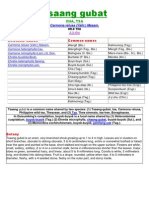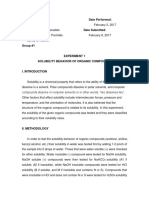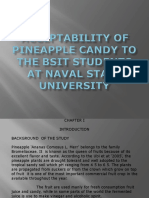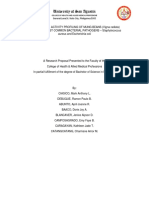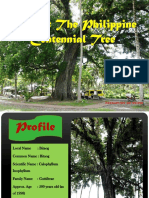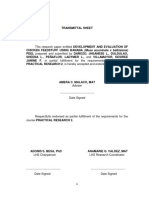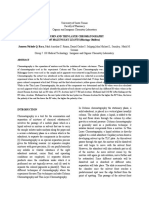Professional Documents
Culture Documents
Ipot Palm (Areca Ipot)
Uploaded by
Charles David Paler0 ratings0% found this document useful (0 votes)
825 views15 pagesTest
Copyright
© © All Rights Reserved
Available Formats
PPTX, PDF, TXT or read online from Scribd
Share this document
Did you find this document useful?
Is this content inappropriate?
Report this DocumentTest
Copyright:
© All Rights Reserved
Available Formats
Download as PPTX, PDF, TXT or read online from Scribd
0 ratings0% found this document useful (0 votes)
825 views15 pagesIpot Palm (Areca Ipot)
Uploaded by
Charles David PalerTest
Copyright:
© All Rights Reserved
Available Formats
Download as PPTX, PDF, TXT or read online from Scribd
You are on page 1of 15
Ipot Palm (Areca ipot)
Submitted By : Charles David Paler
Subject: Botany Lecture 1-A
Areca Ipot
• Is a species of flowering plant in the Arecaceae family.
• It is currently endemic to Philippines and threatened by way of
habitat loss.
• It is smaller than the Betel-Nut, Areca catechu
• In Natives or Tagalog call it “Bunga-Ipot” while the regular “Betle-
Nut” they call it “Bunga” but not as good as those Areca catecha
2 11/22/2018 Add a footer
Taxonomoic Classification
• Domain: Eukaryota
• Kingdom: Plantae
• Phylum: Spermatophyta
• Subphylum: Angiospermae
• Class: Monocotyledonae
• Order: Arecales
• Family: Arecaceae
• Genus: Areca
• Species: Areca ipot
•
• Preferred scientific name: Areca ipot
• Preferred common name: Ipot palm
3 11/22/2018 Add a footer
Habitat / Preferred Environment
• Their habitat is usually in stream sides and
forest in low altitude to medium altitude.
• Geographic distribution is in whole Philippines
but it is common in towns surrounding Mount
Banajao in provinces of South Luzon.
• In cultivation they prefer tropics which is suited
to this plant.
4 11/22/2018 Add a footer
Classification/ Features
• Palms showcase an great variety in p
hysical traits and features.
• It is smaller than Areca catechu
• Requires consistently moist soil; do
not let dry out between watering
• It is an Ornamental Plant according
to (NTFP).
5 11/22/2018 Add a footer
Classification/ features
Size and Habitat :
Mature Height
4m (13.1ft)
Size (mass)
Medium
USDA zone
Zone 11:above 4.5 °C (40 °F)
Distribution
Philippines
Suitable for indoor growing
Yes
6 11/22/2018 Add a footer
Fruit
Fruit Features :
Color when ripe
Red
Size
50mm (2in)
Shape
Oval Shaped
Growth
Unknown
Special Features
Unknown
Trunk
Single or Solitary
Thickness:
Slim
Crownshaft:
Unknown
Color
Green, Brown and Black
Special Feature
Distinct rings
8 11/22/2018 Add a footer
Leaf
Pinnate (Feather)
Color
Dark Green
Size
1.5m in length
Special feature
Unknown
9 11/22/2018 Add a footer
Seed
• The seed is basically is also its fruit, the fruit will eventually fall down
if ripened so much and the fruit will dry and become its seed.
10 11/22/2018 Add a footer
Recent Findings
• Areca Ipot is known to be endemic to Philippines but it is now threatened by
over collection of seeds for betel-nut and population growth that cause
habitat loss.
• The fruit itself are collected for stimulant chewing according to (Haynes, J., &
McLaughlin, J., 2000)
• But studies found that Betel-nut chewing can cause oral cancer
• Areca nut chewing is implicated in oral leukoplakia and submucous fibrosis,
both of which might be potentially malignant inside the oral cavity.
• And the effect of Betel-nut chewing affects almost all organs of the human
body and also affects immune system.
11 11/22/2018 Add a footer
Betel-nut chewing and
deleterious effects on
oral cavity.
12 11/22/2018 Add a footer
Recent findings
• But eventually study additionally founds out that it has also a benefit on it
according to study it contains anti-oxidants and has potential to prevent
oxidative damage in ordinary cells, also study founds it good for wound
healing in skin, ulcers , and also showed its extract is had anti – aging effect
and also study finds that it has Anti-Schizophrenic Effects.
13 11/22/2018 Add a footer
Uses
• The common used part of Areca ipot is its fruit since it was used for betel-nut
chewing
• Areca Ipot used also for ornamental which cause also threat by over-collection
for ornamental purposes according to (Flora and Fauna Welfare Group of the
Philippines)
• It is usually planted in side valleys for landscape purposes
14 11/22/2018 Add a footer
15 11/22/2018 Add a footer
You might also like
- Critical Analysis AssignmentDocument2 pagesCritical Analysis AssignmentHarsh Gosalia0% (1)
- Letter of Recommendation From InternshipDocument1 pageLetter of Recommendation From Internshipposerradio686791% (11)
- Fundamentals of Metal Cutting and Machine Tools by BL Juneja Nitin Seth GsDocument5 pagesFundamentals of Metal Cutting and Machine Tools by BL Juneja Nitin Seth GsSai Akhilesh0% (1)
- BufferDocument3 pagesBufferJessie MorgadoNo ratings yet
- Formal Biochem Lab Report - Isolation and Hydrolysis of GlutenDocument1 pageFormal Biochem Lab Report - Isolation and Hydrolysis of GlutenIke BravoNo ratings yet
- Tsaang GubatDocument5 pagesTsaang GubatLP Benoza100% (1)
- Compendium of Notes in Grade 6 Tle - AgricultureDocument53 pagesCompendium of Notes in Grade 6 Tle - AgricultureC VDNo ratings yet
- Jose Rizal and Philippine NationalismDocument6 pagesJose Rizal and Philippine NationalismBernard CastilloNo ratings yet
- HelgaDocument2 pagesHelgaMubashir RafiqueNo ratings yet
- Response To The Thief by Junichiro TanizakiDocument3 pagesResponse To The Thief by Junichiro TanizakiBaginda NegaraNo ratings yet
- Sample PowerPoint On Feminist TheoriesDocument30 pagesSample PowerPoint On Feminist TheoriesKathlyn Enciso100% (1)
- Fluids Chap 1 2 3Document14 pagesFluids Chap 1 2 3Amiel zurc100% (1)
- Chemical Compositions of Ipomea Aquatica (Green Kangkong)Document7 pagesChemical Compositions of Ipomea Aquatica (Green Kangkong)olangomarkNo ratings yet
- Research Papers in Gullas College of Medicine LibraryDocument9 pagesResearch Papers in Gullas College of Medicine LibraryErlinda PosadasNo ratings yet
- Experiment 4 PDFDocument8 pagesExperiment 4 PDFKami Tazu100% (1)
- Investigatory ProjectDocument6 pagesInvestigatory ProjectDestiny White100% (1)
- Schematic DiagramDocument2 pagesSchematic DiagramMaiSakurajima100% (1)
- BignayDocument4 pagesBignayAngelica Lumanog100% (1)
- Science - Activity 2Document1 pageScience - Activity 2athena sarrah torresNo ratings yet
- Eleucine IndicaDocument8 pagesEleucine Indicariza moralesNo ratings yet
- Answer Sheet FINAL LipidDocument3 pagesAnswer Sheet FINAL LipidFaridah MagumparaNo ratings yet
- Effectiveness of Tuba-Tuba Plant (Jatropha Curcas) As Alternative Muscle Pain RelieverDocument20 pagesEffectiveness of Tuba-Tuba Plant (Jatropha Curcas) As Alternative Muscle Pain RelieverMark Anthony GaboNo ratings yet
- Average Depth and Life Expectancy of Residential Deep Wells in Selected Barangays in Zamboanga CityDocument27 pagesAverage Depth and Life Expectancy of Residential Deep Wells in Selected Barangays in Zamboanga CityZeyad YahyaNo ratings yet
- Experiment No.3 CHM143Document9 pagesExperiment No.3 CHM143MaiSakurajima100% (1)
- Pineapple (Ananas Comosus) and Kamias Extract (Averrhoa Bilimbi) As An Alternative Ingredients in Vinegar Making.Document7 pagesPineapple (Ananas Comosus) and Kamias Extract (Averrhoa Bilimbi) As An Alternative Ingredients in Vinegar Making.Amira BronNo ratings yet
- Talahib Fiber CompositesDocument8 pagesTalahib Fiber CompositesKirsten IgnacioNo ratings yet
- Ampule Box WipDocument1 pageAmpule Box WipCaryl Franchette SamsonNo ratings yet
- Feasibility of Oyster Shell As Stain RemoverDocument25 pagesFeasibility of Oyster Shell As Stain RemoverAnela KimNo ratings yet
- The Utilization of Guava (Psidium Guajava) Leaves Extract As A Preservative For Banana (Musa Acuminata)Document30 pagesThe Utilization of Guava (Psidium Guajava) Leaves Extract As A Preservative For Banana (Musa Acuminata)Jeannel SarmientoNo ratings yet
- Research II Kerson Leaves2.0Document36 pagesResearch II Kerson Leaves2.0Marvielyn100% (1)
- Starch BasedDocument6 pagesStarch BasedBongzkie Irudistan AmanteNo ratings yet
- Study Questions W2Document1 pageStudy Questions W2turiyaleynNo ratings yet
- PCOG Bahay Kubo, Baby Plants, BotanicalDocument3 pagesPCOG Bahay Kubo, Baby Plants, BotanicalRainne Amores VidanesNo ratings yet
- 500 MG Tablet Analgesic - Antipyretic: UnilabDocument1 page500 MG Tablet Analgesic - Antipyretic: UnilabAngelie Nicole BordasNo ratings yet
- Solubility Behavior of Organic CompoundsDocument5 pagesSolubility Behavior of Organic CompoundsIra Candice GumafelixNo ratings yet
- Reflection Paper On BanaueDocument1 pageReflection Paper On BanaueAthena CuevasNo ratings yet
- DUMB CANE /DIE-FFEN-BAKYA/ (Dieffenbachia)Document8 pagesDUMB CANE /DIE-FFEN-BAKYA/ (Dieffenbachia)Jannah A. GrandeNo ratings yet
- Effectiveness of Rice Hull As An Additive in Making BricksDocument9 pagesEffectiveness of Rice Hull As An Additive in Making BricksCelene Pia NgoNo ratings yet
- EXERCISE 9 Lab SheetDocument4 pagesEXERCISE 9 Lab SheetGAILE MEIZTY MOSADANo ratings yet
- Lab 6 Uitm. Soap Preparation. Comparison Soap and Detergent Properties.Document16 pagesLab 6 Uitm. Soap Preparation. Comparison Soap and Detergent Properties.niniwani59No ratings yet
- Results Discussion: ConclusionDocument2 pagesResults Discussion: ConclusionKevinNo ratings yet
- Vol6 No.2-11Document10 pagesVol6 No.2-11SahrulRashidNo ratings yet
- Effectiveness of Kulapo (Phaeophyceae) Powder As Fertilizer On PlantsDocument10 pagesEffectiveness of Kulapo (Phaeophyceae) Powder As Fertilizer On PlantsJerwin SarmientoNo ratings yet
- Hydroponics Mechanism in Growing PetchayDocument2 pagesHydroponics Mechanism in Growing PetchayChedelle Fatima Cajayon FloridoNo ratings yet
- LC No. 11 PPT (Final)Document14 pagesLC No. 11 PPT (Final)Mark Edisol M. AsistioNo ratings yet
- Activity 2B - Reactions To CarbohydratesDocument6 pagesActivity 2B - Reactions To CarbohydratesMy Roses Are RosèNo ratings yet
- Speciation ActivityDocument5 pagesSpeciation Activityapi-382372564No ratings yet
- Botany 3.4 DoneDocument3 pagesBotany 3.4 DoneLeslie Ann Potenciano100% (1)
- Leaf ClassificationsDocument1 pageLeaf ClassificationsWences Joseph Garrido Mijares100% (4)
- Importance of Vegetable Farming: Important Place in Agricultural Development and Economy of The CountryDocument18 pagesImportance of Vegetable Farming: Important Place in Agricultural Development and Economy of The CountryKareen Carlos GerminianoNo ratings yet
- Sample Research ProposalDocument7 pagesSample Research ProposalSejara MabulayNo ratings yet
- Acceptability of Pineapple Candy To The Bsit StudentsDocument4 pagesAcceptability of Pineapple Candy To The Bsit StudentsJMac PadillaNo ratings yet
- Chapter 3 ExampleDocument48 pagesChapter 3 ExampleEmy Sacredfield0% (1)
- Experiment No1 Protein AnalysisDocument3 pagesExperiment No1 Protein AnalysisYellowNo ratings yet
- Section 1: Types of SolutionDocument13 pagesSection 1: Types of SolutionAndreaNicoleBanzonNo ratings yet
- Bitaug PresentationDocument9 pagesBitaug PresentationSyra AlongNo ratings yet
- Environmental Briquette From Water HyacinthDocument2 pagesEnvironmental Briquette From Water HyacinthAlice Del Rosario Cabana33% (3)
- A Critique: Prepared By: Michel Reveche Angel Ligutan Mica Ella Alpas Abegail Sering Loren TorrenuevaDocument7 pagesA Critique: Prepared By: Michel Reveche Angel Ligutan Mica Ella Alpas Abegail Sering Loren Torrenuevaapple joyNo ratings yet
- Density and Specific Gravity Module 2Document2 pagesDensity and Specific Gravity Module 2Ally GuiaoNo ratings yet
- Utilization of Orange Citrus Reticulata Peelings IntoDocument25 pagesUtilization of Orange Citrus Reticulata Peelings IntoXeno ShineNo ratings yet
- Acuesta AquaSci1 Activity2-1-1 PDFDocument2 pagesAcuesta AquaSci1 Activity2-1-1 PDFAngel Mae AcuestaNo ratings yet
- Chapter 1 ResearchDocument13 pagesChapter 1 ResearchSienna ReyesNo ratings yet
- Banana Peel 1 2Document109 pagesBanana Peel 1 2Miguel Salvador ConvocarNo ratings yet
- Lab ReportDocument6 pagesLab ReportMarivic Bencio RacaNo ratings yet
- B. Solubility Test Methods: Samples Hexane Water Ethyl Alcohol 6N HCL 6N Naoh Coconut Oil MargarineDocument1 pageB. Solubility Test Methods: Samples Hexane Water Ethyl Alcohol 6N HCL 6N Naoh Coconut Oil MargarineAlexandra TarucNo ratings yet
- Agasci 111 Module 2Document34 pagesAgasci 111 Module 2Kimberly MuñezNo ratings yet
- More About PapayaDocument3 pagesMore About PapayaismvohraNo ratings yet
- IntroductionDocument6 pagesIntroductionCharles David PalerNo ratings yet
- OdumDocument46 pagesOdumCharles David PalerNo ratings yet
- IntroductionDocument6 pagesIntroductionCharles David PalerNo ratings yet
- IntroductionDocument6 pagesIntroductionCharles David PalerNo ratings yet
- CH 3: Observing Microorganisms Through A MicroscopeDocument21 pagesCH 3: Observing Microorganisms Through A MicroscopepmilyNo ratings yet
- Infected Female Aedes Species Aedes Aegypti or Aedes AlobpictusDocument3 pagesInfected Female Aedes Species Aedes Aegypti or Aedes AlobpictusCharles David PalerNo ratings yet
- Test ScribdDocument1 pageTest ScribdCharles David PalerNo ratings yet
- Infected Female Aedes Species Aedes Aegypti or Aedes AlobpictusDocument3 pagesInfected Female Aedes Species Aedes Aegypti or Aedes AlobpictusCharles David PalerNo ratings yet
- Correction 9Document3 pagesCorrection 9leila saleh100% (1)
- The Goldsmiths Musical Sophistication Index, v1.0: October 11, 2012Document8 pagesThe Goldsmiths Musical Sophistication Index, v1.0: October 11, 2012Paula SGNo ratings yet
- Avmb 1111 Divinely Inspired SayingsDocument44 pagesAvmb 1111 Divinely Inspired SayingsRevival OngoleNo ratings yet
- Ram Charit Manas Bal Kand 0001-0097Document97 pagesRam Charit Manas Bal Kand 0001-0097api-3824888100% (2)
- First Yellow DragoonDocument10 pagesFirst Yellow DragoonCallum McavoyNo ratings yet
- Molesworth House Work and Art WorkDocument28 pagesMolesworth House Work and Art WorkLeah WolffNo ratings yet
- Tutor BlenderDocument46 pagesTutor BlenderThio Cruzh StskNo ratings yet
- A Queen Within Adorned ArchetypesDocument20 pagesA Queen Within Adorned ArchetypesGustavo PradoNo ratings yet
- Saxos AltosDocument2 pagesSaxos AltosJOSE VICENTENo ratings yet
- J. Fry-A - Little - Cartoon - Music-ScoreDocument16 pagesJ. Fry-A - Little - Cartoon - Music-ScoreNaluminoNo ratings yet
- Form 12Document4 pagesForm 12Iris Klench A. BaldovisoNo ratings yet
- DVR Eyemax XVST Magic 08p 16p 16mDocument2 pagesDVR Eyemax XVST Magic 08p 16p 16mSaeful AnwarNo ratings yet
- Waltz de Chocobo From Final FantasyDocument4 pagesWaltz de Chocobo From Final FantasyGoRacerGoNo ratings yet
- Cix Content Index PDFDocument2 pagesCix Content Index PDFJohn ReyNo ratings yet
- A Textile Design StudioDocument18 pagesA Textile Design StudioAkankshaNo ratings yet
- Brief Biography of Nic StoneDocument6 pagesBrief Biography of Nic StoneLanaNo ratings yet
- Design and Construction of A Fusion Depo PDFDocument15 pagesDesign and Construction of A Fusion Depo PDFAnshuShuklaNo ratings yet
- Ekla ChaloDocument6 pagesEkla ChaloSudhakar PandeyNo ratings yet
- Free Time ActivitiesDocument8 pagesFree Time ActivitiesВероника КарплюкNo ratings yet
- C-1. Emphasis: Cleft Sentences Emphatic Constructions: It, What, The Thing ThatDocument4 pagesC-1. Emphasis: Cleft Sentences Emphatic Constructions: It, What, The Thing ThatLidiaAriasCazorla100% (1)
- Pino Family's First Newsletter Final4Document2 pagesPino Family's First Newsletter Final4Rick PinoNo ratings yet
- Storytelling Adventure System Guide (10418857) PDFDocument9 pagesStorytelling Adventure System Guide (10418857) PDFDaniel Ricardo OrtegaNo ratings yet
- ML2Document33 pagesML2Jesse Clarke JamesNo ratings yet





